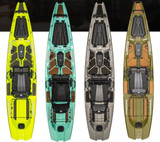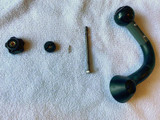What Size Windsurfing Board Do I Need?
Choosing the right size windsurfing board is no trivial decision. Are you aiming to ride big waves or do you prefer flat waters? Your answer will determine the board size you need.
And, while your local windsurfing store might have a plethora of options, knowing your specific requirements beforehand can save you both time and money. This article will guide you through everything you need to know to make an informed decision, allowing you to maximize your performance on the water.
Why Size Matters in Windsurfing
Selecting the right board size is the cornerstone of a satisfying windsurfing experience. It's akin to finding the perfect pair of shoes. If they're too big or too small, you'll end up uncomfortable, and the same applies to wind surf boards.
The size of the board directly influences how well you can control your movements on the water. A large board might offer stability, but it can also be cumbersome and difficult to maneuver. Conversely, a smaller board provides agility but might prove unstable for beginners or in choppy waters.
Let's delve into some specifics. For those just dipping their toes into the windsurfing world, a larger board is often recommended. This is because a bigger board offers greater stability and is more forgiving when you make errors.
It can be an excellent way to learn the ropes without the constant fear of falling into the water. However, these larger boards are often not the best boards for speed or sharp turns which means they may limit you as you advance in skill.
On the other side of the spectrum, smaller boards are tailored for more experienced windsurfers. These boards are built for speed and agility as they allow you to make quick turns and capitalize on the wind's power. Yet, their design makes them less stable, requiring a higher level of skill to control, especially in choppy water conditions or strong winds.
This creates a paradox. While you might aspire for speed and agility, starting with a board that's too small can make the learning curve steep and potentially discourage you from the sport altogether.
Factors Affecting Board Size
Selecting the perfect board size is not a one-size-fits-all endeavor; various elements come into play. Your weight, skill level, and the conditions where you'll be windsurfing all influence this critical choice.
Your Weight Matters
One of the most basic yet crucial considerations in choosing a board size is your own weight. Simply put, the heavier you are, the larger the board you'll likely need. A larger board provides the stability that's crucial, especially if you're a beginner.
Stability is your friend when you're just learning, but keep in mind that a board that's too large can hinder your progress as you become more skilled.
Experience Level
Not all windsurfing boards are created equal, and your skill level plays a significant role in your choice. For those new to windsurfing, a larger, more stable board is generally more forgiving of mistakes.
This is key for understanding windsurfing accessories, which can seem overwhelming to newbies. As you gain more experience and skill, you'll likely want to switch to a smaller board that allows for greater maneuverability and speed.
Types of Water and Wind Conditions
The conditions of the water and wind where you'll be windsurfing also dictate your board size. Calm, flat waters usually allow for a smaller board, while choppy waters with strong winds might require something a bit more robust. Remember, a large board might give you stability, but it can also make it difficult to make quick turns or adjustments.
Matching Board to Purpose
Why are you taking up windsurfing? Is it for leisurely afternoons on the lake, or do you have dreams of speedy ocean windsurfing? Your purpose will guide your choice.
If speed is your game, a smaller board will be more agile and responsive. On the other hand, if you're in it for the relaxation and the scenery, a larger board will offer the stable, leisurely ride you're after.
The Different Types of Boards and Their Sizes
Choosing the right board is a pivotal decision in your windsurfing experience, and it's not just about size. Different types of boards are designed to meet specific needs, from the beginner's initial steps to the seasoned pro's aerial tricks.
Beginner Boards: Stability Over Speed
When you go windsurfing for the first time, the type of board you'll want to start with is a beginner board. These boards are generally larger and provide the stability needed when you're just starting out.
As you're getting a feel for windsurfing, these boards are more forgiving and help you understand the basics without too many tumbles into the water. While they aren't the best boards for high-speed or advanced maneuvers, they offer a good starting point for windsurfing for beginners.
Freeride Boards: The Middle Ground
Freeride boards are for windsurfers who have moved past the beginner stage but aren't yet into hardcore competitive windsurfing. These boards are versatile and can handle a range of conditions.
They're good for a variety of windsurfing styles, whether you're interested in leisurely gliding or more exciting turns and jumps. This is often the point where people start to consider more advanced windsurfing sails and other windsurfing accessories.
Wave Boards: For the Adventurous
Wave boards are for those who love the adrenaline rush and want to ride the waves with agility and speed. These boards are smaller and lighter, designed to handle the dynamic conditions of wave sailing.
You can execute sharp turns and aerial maneuvers that wouldn't be possible with larger boards. If the thrill of the sport is what gets you going, then wave boards are where you'll want to be.
Racing Boards: Speed is Key
If competition and speed are your things, then a racing board may be the right fit. These boards are built for just one thing: going as fast as possible. Their design is aerodynamic, and they often come with specialized sails to help you harness even the lightest winds for incredible speeds.
When you're ready to buy a new board for racing, remember that the need for speed requires advanced skills.
Freestyle Boards: Show Off Your Skills
These boards are designed for doing tricks and stunts. Freestyle boards are often smaller and more maneuverable and give you the freedom to express yourself on the water.
However, these boards are usually for more experienced windsurfers. Newcomers might find them tricky to control.
How to Shop for Your Board at a Windsurfing Store
Before you head to a windsurfing store, make sure you have a clear idea of what you need. You should already have decided on the type of board that fits your skill level and goals.
Are you aiming to go windsurfing for leisure or are you gearing up for competitive events? Being aware of your needs will make the shopping process smoother and more efficient.
Assess the Store's Offering
When you arrive at the windsurfing store, you'll find a variety of boards to choose from. While it can be tempting to go for the flashiest or most expensive option, keep your focus on what suits your needs. Take your time, look around, and maybe even chat with a representative to get some advice tailored to you.
Test the Waters
If the store provides the option, it's often a good idea to test out a few boards. This hands-on experience is invaluable. It allows you to get a feel for the board's stability, maneuverability, and how it responds to your movements.
Price and Quality
Budget considerations are important, but don't let price be the only factor in your decision. Sometimes, spending a bit more upfront can save you from headaches down the road.
Additionally, if you're keen on specific windsurfing sails or other accessories, you'll need to factor those into your budget as well. Remember, a good board is an investment in your enjoyment and safety on the water.
Ask for Recommendations
Don't be shy to ask for opinions, either from store representatives or from friends who are seasoned windsurfers. They can offer valuable insights and may even point you toward promotions or deals you weren't aware of. If you're a beginner, their advice can be especially beneficial.
Final Thoughts Before Purchase
Before making that final decision, take a moment to reflect. Think about how often you plan to go windsurfing, under what conditions, and what you want to achieve. Make sure the board aligns with your needs and desires for the best possible experience.
Your Windsurfing Adventure Awaits
You've made it to the end and, by now, you should have a clear understanding of what size windsurfing board is perfect for you. Whether you are looking for boards that are apt for strong winds or calmer waters, your choice will significantly impact your time on the water.
If you're still in doubt, Liquid Surf and Sail, America's premium water sports retailer, is ready to assist you. Why gamble with your windsurfing experience? Visit our windsurfing store today and check out our full range of boards to find the one that meets your needs.
Recent Posts
-
Understanding the New USCG Life Jacket Levels System for watersports.
Understanding new Changes in PFD Regulations for watersports. If you've been shopping for a new Life …4th Nov 2025 -
Understanding Kayak Manufacturing and Materials
Understanding Kayak Manufacturing: Rotomolded, Blow Molded, Thermoformed & Composite Kayaks Choos …25th Jun 2025 -
FeelFree 8 Ball Steering System setup, adjustment and cable replacement.
FeelFree 8 Ball Steering System setup, adjustment and cable replacement. Feelfree’s 8 Ball S …9th May 2025



